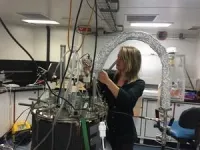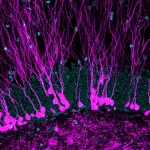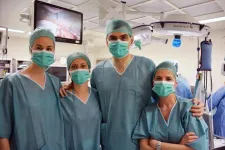(Press-News.org) HOUSTON – (April 5, 2024) – If you were to throw a message in a bottle into a black hole, all of the information in it, down to the quantum level, would become completely scrambled. Because in black holes this scrambling happens as quickly and thoroughly as quantum mechanics allows. They are generally considered nature’s ultimate information scramblers.
New research from Rice University theorist Peter Wolynes and collaborators at the University of Illinois Urbana-Champaign, however, has shown that molecules can be as formidable at scrambling quantum information as black holes. Combining mathematical tools from black hole physics and chemical physics, they have shown that quantum information scrambling takes place in chemical reactions and can nearly reach the same quantum mechanical limit as it does in black holes. The work is published online in the Proceedings of the National Academy of Sciences.
“This study addresses a long-standing problem in chemical physics, which has to do with the question of how fast quantum information gets scrambled in molecules,” Wolynes said. “When people think about a reaction where two molecules come together, they think the atoms only perform a single motion where a bond is made or a bond is broken.
“But from the quantum mechanical point of view, even a very small molecule is a very complicated system. Much like the orbits in the solar system, a molecule has a huge number of possible styles of motion ⎯ things we call quantum states. When a chemical reaction takes place, quantum information about the quantum states of the reactants becomes scrambled, and we want to know how information scrambling affects the reaction rate.”
To better understand how quantum information is scrambled in chemical reactions, the scientists borrowed a mathematical tool typically used in black hole physics known as out-of-time-order correlators, or OTOCs.
“OTOCs were actually invented in a very different context about 55 years ago, when they were used to look at how electrons in superconductors are affected by disturbances from an impurity,” Wolynes said. “They’re a very specialized object that is used in the theory of superconductivity. They were next used by physicists in the 1990s studying black holes and string theory.”
OTOCs measure how much tweaking one part of a quantum system at some instant in time will affect the motions of the other parts ⎯ providing insight into how quickly and effectively information can spread throughout the molecule. They are the quantum analog of Lyapunov exponents, which measure unpredictability in classical chaotic systems.
“How quickly an OTOC increases with time tells you how quickly information is being scrambled in the quantum system, meaning how many more random looking states are getting accessed,” said Martin Gruebele, a chemist at Illinois Urbana-Champaign and co-author on the study who is a part of the joint Rice-Illinois Center for Adapting Flaws as Features funded by the National Science Foundation. “Chemists are very conflicted about scrambling in chemical reactions, because scrambling is necessary to get to the reaction goal, but it also messes up your control over the reaction.
“Understanding under what circumstances molecules scramble information and under what circumstances they don’t potentially gives us a handle on actually being able to control the reactions better. Knowing OTOCs basically allows us to set limits on when this information is really disappearing out of our control and conversely when we could still harness it to have controlled outcomes.”
In classical mechanics, a particle must have enough energy to overcome an energy barrier for a reaction to occur. However, in quantum mechanics, there’s the possibility that particles can “tunnel” through this barrier even if they don’t possess sufficient energy. The calculation of OTOCs showed that chemical reactions with a low activation energy at low temperatures where tunneling dominates can scramble information at nearly the quantum limit, like a black hole.
Nancy Makri, also a chemist at Illinois Urbana-Champaign, used path integral methods she has developed to study what happens when the simple chemical reaction model is embedded in a larger system, which could be a large molecule’s own vibrations or a solvent, and tends to suppress chaotic motion.
“In a separate study, we found that large environments tend to make things more regular and suppress the effects that we’re talking about,” Makri said. “So we calculated the OTOC for a tunneling system interacting with a large environment, and what we saw was that the scrambling was quenched ⎯ a big change in the behavior.”
One area of practical application for the research findings is to place limits on how tunneling systems can be used to build qubits for quantum computers. One needs to minimize information scrambling between interacting tunneling systems to improve the reliability of quantum computers. The research could also be relevant for light-driven reactions and advanced materials design.
“There’s potential for extending these ideas to processes where you wouldn’t just be tunneling in one particular reaction, but where you’d have multiple tunneling steps, because that’s what’s involved in, for example, electron conduction in a lot of the new soft quantum materials like perovskites that are being used to make solar cells and things like that,” Gruebele said.
Wolynes is Rice’s D.R. Bullard-Welch Foundation Professor of Science, a professor of chemistry, f biochemistry and cell biology, physics and astronomy and materials science and nanoengineering and co-director of its Center for Theoretical Biological Physics, which is funded by the National Science Foundation. Co-authors Gruebele is the James R. Eiszner Endowed Chair in Chemistry; Makri is the Edward William and Jane Marr Gutgsell Professor and professor of chemistry and physics; Chenghao Zhang was a graduate student in physics at Illinois Urbana-Champaign and is now a postdoc at Pacific Northwest National Lab; and Sohang Kundu recently received his Ph.D. in chemistry from the University of Illinois and is currently a postdoc at Columbia University.
The research was supported by the National Science Foundation (1548562, 2019745, 1955302) and the Bullard-Welch Chair at Rice (C-0016).
-30-
This press release can be found online at news.rice.edu.
Follow Rice News and Media Relations via Twitter @RiceUNews.
Peer-reviewed paper:
“Quantum information scrambling and chemical reactions” | Proceedings of the National Academy of Sciences | DOI: 10.1073/pnas.2321668121
Authors: Chenghao Zhang, Sohang Kundu, Nancy Makri, Martin Gruebele and Peter Wolynes
https://doi.org/10.1073/pnas.2321668121
Image downloads:
https://news-network.rice.edu/news/files/2024/04/BlackHoleMolecule2-0387e2be407aefaa.jpg
CAPTION: Rice University theorist Peter Wolynes and collaborators at the University of Illinois Urbana-Champaign have shown that molecules can be as formidable at scrambling quantum information as black holes. (Image courtesy of Martin Gruebele; DeepAI was used in the making of the image)
https://news-network.rice.edu/news/files/2024/04/Wolynes_Makri_Gruebele-3e4286b5ec5ad9fc.jpg
CAPTION: Peter Wolynes (from left), Nancy Makri and Martin Gruebele (Photo of Wolynes Gustavo Raskosky/Rice University; photo of Makri courtesy of Nancy Makri; photo of Gruebele by Fred Zwicky/University of Illinois Urbana-Champaign)
https://news-network.rice.edu/news/files/2024/04/Zhang_Kundu-66fa4d09a6f863a9.jpg
CAPTION: Chenghao Zhang (left) and Sohang Kundu (Photo of Zhang by Bill Wiegand/University of Illinois Urbana-Champaign; photo of Kundu courtesy of Sohang Kundu)
Related stories:
Theory can sort order from chaos in complex quantum systems:
https://news.rice.edu/news/2023/theory-can-sort-order-chaos-complex-quantum-systems
Rice lab’s quantum simulator delivers new insight:
https://news.rice.edu/news/2022/rice-labs-quantum-simulator-delivers-new-insight
NSF renews Rice biological physics center:
https://news.rice.edu/news/2020/nsf-renews-rice-biological-physics-center
Links:
Center for Adapting Flaws as Features: https://nsfcaff.org/
Gruebele Lab: https://gruebele-group.chemistry.illinois.edu/
BioScience Research Collaborative: https://brc.rice.edu/
Center for Theoretical Biological Physics: https://ctbp.rice.edu/
Department of Chemical and Biomolecular Engineering: https://chbe.rice.edu/
Department of Chemistry: https://chemistry.rice.edu/
Department of Physics and Astronomy: https://physics.rice.edu/
George R. Brown School of Engineering: https://engineering.rice.edu
Ken Kennedy Institute: https://kenkennedy.rice.edu/
Wiess School of Natural Sciences: https://naturalsciences.rice.edu
Wolynes Research Lab: https://wolynes.rice.edu/
Makri Group: http://makri.scs.illinois.edu/
Department of Chemistry, University of Illinois: https://chemistry.illinois.edu/
About Rice:
Located on a 300-acre forested campus in Houston, Rice University is consistently ranked among the nation’s top 20 universities by U.S. News & World Report. Rice has highly respected schools of architecture, business, continuing studies, engineering, humanities, music, natural sciences and social sciences and is home to the Baker Institute for Public Policy. With 4,574 undergraduates and 3,982 graduate students, Rice’s undergraduate student-to-faculty ratio is just under 6-to-1. Its residential college system builds close-knit communities and lifelong friendships, just one reason why Rice is ranked No. 1 for lots of race/class interaction, No. 2 for best-run colleges and No. 12 for quality of life by the Princeton Review. Rice is also rated as a best value among private universities by Kiplinger’s Personal Finance.
END
Chemical reactions can scramble quantum information as well as black holes
2024-04-05
ELSE PRESS RELEASES FROM THIS DATE:
With VECSELs towards the quantum internet
2024-04-05
The expansion of fiber optics is progressing worldwide, which not only increases the bandwidth of conventional Internet connections, but also brings closer the realization of a global quantum Internet. The quantum internet can help to fully exploit the potential of certain technologies. These include much more powerful quantum computing through the linking of quantum processors and registers, more secure communication through quantum key distribution or more precise time measurements through the synchronization of atomic clocks.
However, the differences between the glass fiber standard of 1550 nm and the system wavelengths of the various quantum bits ...
Two sex pheromone receptors for sexual communication in the American cockroach
2024-04-05
Sex pheromones are vital in facilitating the chemical communication that underpins insect courtship and mating behavior. Among female American cockroaches (Periplaneta americana), two key volatile sex pheromone components, periplanone-A (PA) and periplanone-B (PB), are predominantly released. Previous studies have indicated that PB is the primary component, but the precise interplay between PA and PB, alongside their regulatory mechanisms in male courtship and mating behavior has remained ambiguous.
Recently, a team led by Professor Sheng Li from the Institute of Insect Science and Technology, School of Life Sciences, South China Normal ...
WVU spearheading regional USDA project to increase agricultural production
2024-04-05
West Virginia University is leading one of 50 projects as part of a nationwide effort to increase farmland availability to underserved populations, while also helping producers obtain working capital and means of food distribution.
The WVU Institute for Community and Rural Health was awarded a five-year, $8.5 million cooperative agreement grant for the U.S. Department of Agriculture’s Increasing Land Access Program, funded by President Joe Biden’s Inflation Reduction Act.
Titled “Working Lands of Central Appalachia,” ...
UM Researcher writes about a key issue for the US 2024 elections: Air pollution exposures ought to be of significant interest for US voters
2024-04-05
MISSOULA – An opinion paper published by University of Montana professor Lilian Calderón-Garcidueñas MD, PhD identifies air pollution risk exposures and the development of Alzheimer’s and Parkinson’s diseases, frontotemporal lobar degeneration (FTLD) and amyotrophic lateral sclerosis (ALS) in exposed populations.
Calderón-Garcidueñas coauthors, Dr. Alberto Ayala and Dr. Partha Mukherjee discussed US citizens are not fully aware of the harmful brain impact of exposures to ubiquitous anthropogenic combustion emissions and friction-derived nanoparticles, industrial nanoplastics, wildfires and ...
Electronic medical record tool helps clinicians diagnose mpox
2024-04-05
Diagnosing infectious conditions can be challenging. Diagnosis is especially challenging for uncommon and emerging infectious diseases for which there’s limited clinical experience. Nevertheless, successfully identifying patients with infectious diseases, especially communicable ones, is critical, so patients can be isolated to reduce disease spread.
To address this challenge, investigators from Massachusetts General Hospital, a founding member of the Mass General Brigham healthcare system, recently developed and validated a computer program that can be incorporated into electronic medical record systems to help clinicians diagnose mpox (formerly known as monkeypox).
The research ...
University support boosts West Midlands economy by £450 million – For every £1 invested, £22 returned to the local economy
2024-04-05
WMG at the University of Warwick has boosted the West Midlands economy by £450 million – with every £1 invested into WMG’s small and medium enterprise (SME) programmes, around £22 has returned to the local economy.
Celebrating 20 years of tailored business support, WMG has delivered manufacturing expertise to 15,000 SMEs in the Midlands. It has supported the creation of more than 13,000 jobs, 350 new businesses and 355 internships over the last two decades.
WMG has delivered critical projects to SMEs to help them succeed in digitalisation, business change and product design. A key ongoing project is helping SMEs mange the energy crisis with a specialised ...
$1.9 million awarded to create device that will reduce death from bleeding
2024-04-05
The Department of Defense awarded a little more than $1.9 million to a multidisciplinary team of researchers at the University of Arkansas and University of Arkansas for Medical Sciences to develop a wearable device that will assist with the early detection and monitoring of internal and external bleeding. The grant comes as part of the Department of Defense’s prestigious Congressionally Directed Medical Research Programs.
Hemorrhagic shock is currently the leading cause of preventable death in casualty care settings. Existing methods often fail to detect blood loss until the onset of shock, which can be too late for some patients. This makes early detection and management ...
Renowned St. Jude clinician and researcher to receive coveted award at AACR annual meeting
2024-04-05
Scientists at St. Jude Children’s Research Hospital are preparing to demonstrate their expertise and foster collaborations at the American Association for Cancer Research (AACR) annual meeting. It will be held April 5-10, 2024 in San Diego, California.
Each year, members of the cancer research community including scientists, clinicians, healthcare professionals, cancer survivors, patients and advocates attend AACR’s annual meeting. It provides an opportunity for St. Jude researchers to share their research findings ...
Fuelling nerve cell function and plasticity
2024-04-05
Nerve cells (neurons) are amongst the most complex cell types in our body. They achieve this complexity during development by extending ramified branches called dendrites and axons and establishing thousands of synapses to form intricate networks. The production of most neurons is confined to embryonic development, yet few brain regions are exceptionally endowed with neurogenesis throughout adulthood. It is unclear how neurons born in these regions successfully mature and remain competitive to exert their functions within a fully formed organ. However, understanding these processes holds great potential for brain repair approaches during disease.
A team ...
First cardiac bioimplants for the treatment of patients with myocardial infarction using umbilical cord stem cells
2024-04-05
The results of a pioneering study support the safety of the bioimplants called PeriCord, made from stem cells of the umbilical cord and pericardium from a tissue donor, which aid in the regeneration and revascularisation of the affected area.
The study has monitored 7 interventions of this pioneering tissue engineering surgery over three years, noting excellent biocompatibility and no rejection in patients.
The therapy has been developed by the research group ICREC (Heart Failure and Cardiac Regeneration) at Germans Trias i Pujol Research ...









